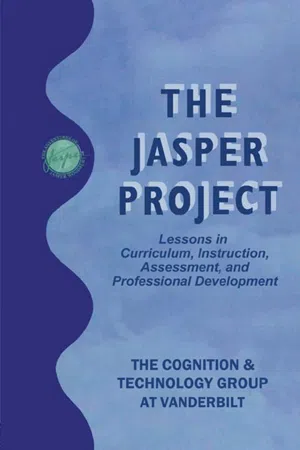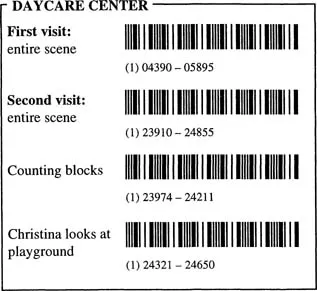![]()
1
Overview of the Jasper Series
OVERVIEW OF THE JASPER ADVENTURES
The Jasper series consists of 12 videodisc-based adventures (plus video-based analogs, extensions, and teaching tips) that focus on mathematical problem finding and problem solving. The 12 adventures are illustrated in Fig. 1.1. Each adventure is designed from the perspective of the standards recommended by the National Council of Teachers of Mathematics (NCTM). In particular, each adventure provides multiple opportunities for problem solving, reasoning, communication, and making connections to other areas such as science, social studies, literature, and history (NCTM, 1989, 1991).
Jasper adventures are designed for students in grades 5 and up. Each videodisc contains a short (approximately 17-minute) video adventure that ends in a complex challenge. The adventures are designed like good detective novels, where all the data necessary to solve the adventure (plus additional data that are not relevant to the solution) are embedded in the story. Jasper adventures also contain embedded teaching scenes that provide models of particular approaches to solving problems. These episodes can be revisited on a just-in-time basis as students need them to solve the Jasper challenges.
Descriptions of the Jasper Adventures
Summaries of the 12 Jasper adventures appear in Appendix A. The adventures can be used in any order, although they do differ in complexity. In general, the adventures in the left-most column of Fig. 1.1are the simplest and those in the right-most column are the most advanced.
Some teachers like to focus on a particular area (e.g., trip planning, geometry) and have students proceed from the simplest to most complex adventures in that area. Other teachers prefer to use one adventure from each topic area (trip planning, statistics, geometry, algebra). They usually have students begin with the simplest adventures in each area and graduate to the more difficult ones in succeeding years. Other teachers mix and match the adventures in ways that help them integrate Jasper instruction into other content areas. For example, Get Out the Vote is especially good for linking to social studies and history; Bridging the Gap is excellent for focusing on endangered species and changing populations, and so forth.
FIG. 1.1. The 12 Jasper adventure.
Solving a Jasper Adventure
Our experiences indicate that, in order to understand Jasper , it is imperative to attempt to solve at least one of the adventures. It is not sufficient to simply watch Jasper; the important experience is in the solving of it. (A motto that accompanies Jasper is, “It's not just a movie; it's a challenge.”) The challenge is most fun and meaningful when solved collaboratively.
We include the Jasper adventure Rescue at Boone's Meadow on the CD-ROM that accompanies this book. We strongly recommend that you watch it and attempt to solve it (ideally, with one or more friends) before proceeding further. If you do not have access to a CD-ROM player, use the external summary of the adventure provided in Appendix B. However, please note that, for many reasons that will be discussed throughout this book, the use of Jasper summaries is far less desirable than the use of the video adventure.
DESIGN OF THE JASPER SERIES
Each adventure in the Jasper series was developed according to a set of design principles that emerged as we studied students' problem solving. As a result, the Jasper series is different from many other materials produced for mathematics. The following sections describe eight features of Jasper that differentiate it from many traditional approaches to mathematics instruction.
Jasper Helps Students Learn Mathematics While Solving Problems in Authentic Contexts
Often, students study mathematics by first learning isolated skills. Then they apply the skills by solving narrowly defined problems that provide practice for the skills, When students use Jasper , they learn mathematics as they try to solve the challenge. They develop and learn mathematical concepts and skills as they need them through just-in-time instruction. Although some teachers who use Jasper for the first time feel the need to teach all of the relevant concepts and vocabulary to students before they watch the adventure, teachers who use Jasper usually report that students learn mathematics (concepts, skills, symbols, and vocabulary) as they attempt to solve the challenge.
The use of mathematics in authentic contexts supports students' reasoning, problem solving, and communication skills, all standards identified by the NCTM (1989). In accordance with the national standards, each adventure provides multiple opportunities for using these skills and making connections to other areas such as science, social studies, literature, and history (NCTM, 1989, 1991). In her review of the Jasper Series for Technology and Learning , Eiser (1975) stated: “Of the products we have looked at, the one that most fully incorporates the ideas expressed in the NCTM standards—including mathematical sophistication, stress on group work, and real-world relevance, is the Jasper Series.”
A Jasper Adventure Provides a Context That Helps Students Integrate Concepts in Mathematics As Well As Mathematical Knowledge With Knowledge of Other Subjects
In traditional mathematics classrooms, students often study one concept or skill at a time. For example, they might study fractions, followed by decimals, followed by percentages, and so on. In a Jasper adventure, there are several concepts and skills that are embedded in the context of the story. Students can begin to develop an understanding of these skills and concepts concurrently by using their own knowledge to reason about the story. This often results in different strategies and mathematical concepts being used by different groups as they solve the challenge. For example, in solving The Big Splash , students must estimate the number of students in Chris' school who will buy a ticket to the dunking booth, using some sample data that Chris collected. Some students reason about the data using fractions although other students use percentages. As students share their solutions, they have the opportunity to connect their understanding of fractions with their understanding of percentages. Learning mathematics in the context of the video story provides many opportunities for students to make these types of mathematical connections.
Each Jasper adventure also includes links to other subjects and opportunities for students to learn things in addition to mathematics. For example, in Rescue at Boone s Meadow , the character Larry explains the aerodynamics of an ultralight aircraft and how the wings help the plane stay in the air. This scene can anchor a discussion about science in the same way that other scenes anchor discussions about mathematics. As one Jasper teacher said, “In life, things that we learn are not separated. Jasper helps learning be more like real life.”
Jasper Takes Advantage of the Power of Video and Interactive Technologies
The Jasper adventures are in visual rather than textual formats and are on videodisc rather than videotape. Video allows a more veridical representation of events than text. It is dynamic, visual, and spatial, and students can more easily form rich mental models of the problem situations (e.g., Johnson-Laird, 1985; McNamara, Miller, & Bransford, 1991; Sharp et al., 1995). This characteristic is particularly important for nontraditional students and for students with little knowledge in the domain being studied (Bransford, Kinzer, Risko, Rowe, & Vye, 1989; Johnson, 1987). Teachers who have used Jasper have told us that their students who had difficulty in reading were able to contribute to Jasper solutions and gained new respect from their peers.
Videodisc technology also has random-access capabilities that allow teachers almost instant access to information for discussion (see Sherwood, Kinzer, Bransford, & Franks, 1987). This makes it easy for students to re-explore the video in order to find the relevant data and just-in-time embedded teaching.
At the simplest level, Jasper adventures require only a videodisc player with a handheld controller or barcode reader. A single player on a cart can be moved from classroom to classroom. Students can re-explore the story by using the rapid scan or frame numbers on a handheld remote videodisc controller (see Fig. 1.2), or using barcode technology (see Fig. 1.3).
FIG. 1.2. Student using a hand-held videodisc controller.
FIG. 1.3. Barcode technology.
At more sophisticated levels of implementation, Jasper includes optional computer software. For example, computer map controllers allow students to click on locations that are represented in the story and return to them almost instantly. A map controller for Journey to Cedar Creek is illustrated in Fig. 1.4.
We discourage the use of Jasper on videotape because it is cumbersome to rewind the video in order to find relevant data. As a result, teachers who use videot...



